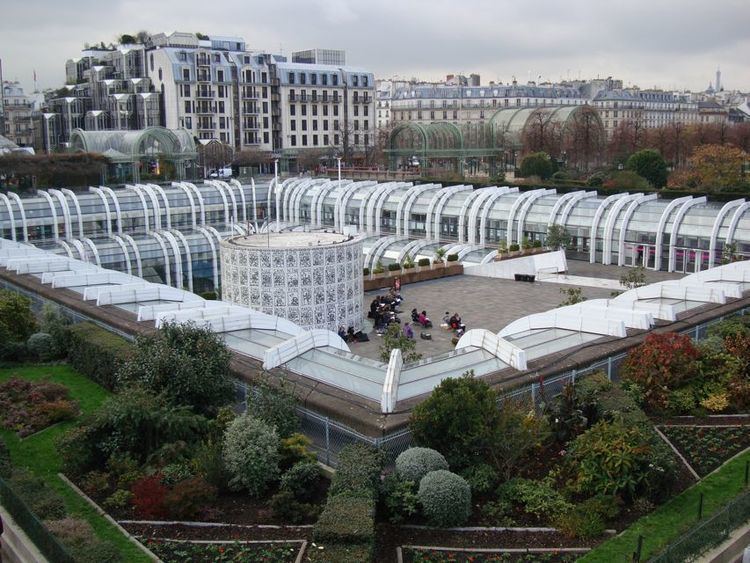Total retail floor area 60,000 square metres Website forumdeshalles.com | No. of stores and services 168 Parking 2,100 spaces Number of stores and services 168 | |
 | ||
Opening date 1979,reconstruction by 2018 Restaurants Hotel Novotel Paris les, Le Paris Halles, AG Les Halles, Duc des Lombards, Chez Simone Similar Gare de Châtelet – Les Halles, Le Marais, Saint‑Germain‑des‑Prés, Latin Quarter - Paris, Place du Châtelet | ||
Les halles
Les Halles de Paris, usually simply Les Halles ([le al], The Halls), was Paris's central fresh food market. Located in the heart of the city, it was demolished in 1971 and replaced with the Forum des Halles, a modern shopping mall built largely underground and directly connected to the massive RER and métro transit hub of Châtelet-Les-Halles. The shopping mall welcomes 150,000 visitors daily.
Contents
- Les halles
- Map of Les Halles 75001 Paris France
- Les halles invisible cities 2014
- The wholesale market
- Major conversion
- Paris Les Halles an urban transit hub to redevelop
- In film
- References
Map of Les Halles, 75001 Paris, France
Since 2010, a major reconstruction of the mall is under progress. The new version is planned to be inaugurated by 2016. The mall remains open during works. In 2013, the Forum des Halles was still the second most visited shopping mall in France with 39.2 million visitors.
Les halles invisible cities 2014
The wholesale market
Les Halles was the traditional central market of Paris. In 1183, King Philippe II Auguste enlarged the marketplace in Paris and built a shelter for the merchants, who came from all over to sell their wares. The church of Saint-Eustache was constructed in the 16th century. The circular Halle aux Blés (Corn Exchange), designed by Nicolas Le Camus de Mézières, was built between 1763 and 1769 at the west end of Les Halles. Its circular central court was later covered with a dome, and it was converted into the Bourse de Commerce in 1889. In the 1850s, Victor Baltard designed the famous glass and iron buildings, Les Halles, which would last until the 1970s. Les Halles was known as the "Belly of Paris", as it was called by Émile Zola in his novel Le Ventre de Paris, which is set in the busy marketplace of the 19th century.
Major conversion
Unable to compete in the new market economy and in need of massive repairs, the colourful ambience once associated with the bustling area of merchant stalls disappeared in 1971, when Les Halles was dismantled; the wholesale market was relocated to the suburb of Rungis. Two of the glass and cast iron market pavilions were dismantled and re-erected elsewhere; one in the Paris suburb of Nogent-sur-Marne, the other in Yokohama, Japan.
The site was to become the point of convergence of the RER, a network of new express underground lines which was completed in the 1960s. Three lines leading out of the city to the south, east and west were to be extended and connected in a new underground station. For several years, the site of the markets was an enormous open pit, nicknamed "le trou des Halles" (trou = hole), regarded as an eyesore at the foot of the historic church of Saint-Eustache. Construction was completed in 1977 on Châtelet-Les-Halles, Paris's new urban railway hub. The Forum des Halles, a partially underground multiple story commercial and shopping center, opened at the east end of the site in 1979 and remains there today. A public garden covering four hectares opened in 1986. Many of the surrounding streets were pedestrianized.
Paris Les Halles: an urban transit hub to redevelop
Gare de Châtelet – Les Halles is Paris's most used rail station, serving 750,000 travelers on an average weekday. The buildings and their surroundings have been criticized for their design. In 2002 Mayor Bertrand Delanoë announced that the City of Paris would begin public consultations regarding the remodeling of the area, calling Les Halles "a soulless, architecturally bombastic concrete jungle".
A design competition for the Forum and gardens was held, with entries from Jean Nouvel, Winy Maas, David Mangin, and Rem Koolhaas. Mangin's design for the gardens, which proposed replacing the landscaped mounds and paths of the 1980s design with a simplified pattern of east-west pedestrian promenades and a large central lawn, was selected. The plan also includes extending the pedestrianized area further east to include all the streets bordering the gardens. Another competition was held for the redesign of the Forum. Ten teams submitted plans, and the proposal by Patrick Berger and Jacques Anziutti was selected in 2007. Their design includes a large undulating glass canopy which will cover the redesigned Forum. STIF and RATP began plans for the remodeling of the Châtelet-Les-Halles station in 2007, and the following year Berger and Anziutti were awarded a contract for redesign of the station.
The station redesign includes new entrances on Rue Berger, Rue Rambuteau, and Place Marguerite de Navarre, an expanded RER concourse, and improved pedestrian circulation. Construction began in 2010 on a project which includes the gardens, Forum, and station, and is scheduled to continue through 2016. The clients are the City of Paris, RATP, which operates the Paris Metro, and La Société Civile du Forum des Halles de Paris, which operates the Forum.
In film
Part of the actual demolition of the site is featured in the 1974 film Touche pas à la femme blanche (Don't Touch the White Woman!), which iconoclastically restages General Custer's 'last stand' in a distinctly French context in and around the area.
In 1977, Roberto Rossellini made a 54-minute documentary film that testified to the public's response to the demolition of Les Halles and the construction of Centre Georges Pompidou. "The result was a sceptical vision rather than a pure celebration."
The open-air market and Baltard's pavilions were digitally reconstructed for the 2004 film Un long dimanche de fiançailles (A Very Long Engagement), which was set after the First World War.
